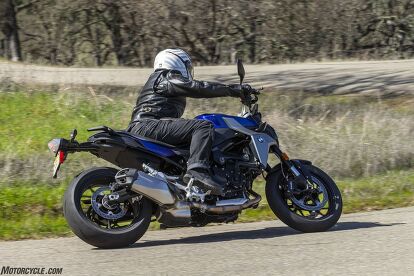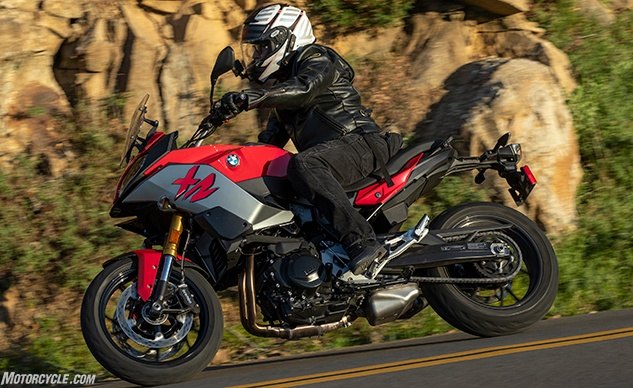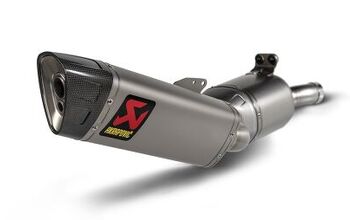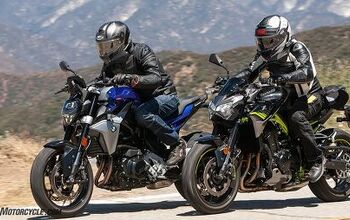2020 BMW F 900 R and F 900 XR Review – First Ride
BMW is out to eat your pie, drink your milkshake...
The pie, everyone agrees, is shrinking, and nobody can agree on how to bake a new one. Many, if not most industry people seem to have concluded millennials are just cell phone-addicted slackers, though slackers is not the word many of them use in private conversation. What it’s all about now, then, is conquest sales, and when the Germans start talking conquest, people listen. One way to conquer is by lowering prices, which would seem to suggest the slackification could be a money-related issue, wouldn’t it? I can’t remember the last time BMW admitted to taking aim at a specific competitor, but for the new F 900 XR in our lead image, it’s the Yamaha Tracer 900. For the barer-boned F 900 R, it’s the Kawasaki Z900 – both rich targets and great bargains.
2020 BMW F 900 R
| Engine | 17.5/20 |
| Suspension/Handling | 14.0/15 |
| Transmission/Clutch | 8.0/10 |
| Brakes | 9.0/10 |
| Instruments/Controls | 4.5/5 |
| Ergonomics/Comfort | 7.5/10 |
| Appearance/Quality | 8.5/10 |
| Desirability | 8.5/10 |
| Value | 9.0/10 |
| Overall Score | 86.5/100 |
Your F 800 R was a pleasant enough motorcycle, with emphasis on design, easy handling, affordability… With the new 900 versions, BMW moves the bike more in an S 1000 R direction, stressing sportiness, with visuals and performance “considerably more aggressive” than the 800.
F 900 R
To that end, we’ve got an all-new frame with more torsional rigidity and a stiffer swingarm. Attached to it are footpegs 0.6-inch higher and 0.2-in rearward, and the handlebar moves 1 inch forward. Gas moves from under the seat to the traditional spot, all of which makes the 900 a tad more front-wheel centric. Though the target may have been Z900, I was surprised to find myself thinking KTM Duke 790 after a few sections of curves. The chassis feels way more nimble, solid and eager than the F 800 R, and the suspension really does move to the sporty side of the equation, with really firm springs and damping, firmer than the Duke.
On smooth pavement, the ride is fantastic. Unfortunately we’re almost out of smooth pavement even in bucks-up Santa Barbara county. Roughly half of California was last paved before Columbus discovered the place, and over those sections, softer springs would be preferable for all but masochists. Still, if you’re man or woman enough, you can skate over the nasty sections like McGrath through the whoops, bottoming the rear now and then over only the gnarrest ones. There’s an unobtrusive steering damper tucked under there, and we experienced nary a bar waggle.
The seat is on the thin side, too, to keep it low for people of small stature, who bought a lot of F 800s; 10% of its buyers were women says BMW. Overall, this is a really compact motorcycle that BMW says weighs in at 465 pounds with its 3.4-gallon tank full (oh no, another too-small gas tank). Dang, that’s actually 54 pounds heavier than the Duke 790 and only 10 less than the Suzuki Katana.
Still, the BMW has the Duke’s same quick-reacting sure-footed feel when you start to ride it hard in the curves. The press kit says: Adjustments in the area of the steering head (steeper steering head angle, a modified offset, increased castor as compared to the GS models) make for a particularly sporty suspension design. The more even wheel load distribution with a favorable center of gravity, the high torsional stiffness of the main frame and a stiffer swing arm result in a tangible increase in agility, precision and riding stability for the rider. As a dynamic roadster, the new F 900 R is dedicated above all to sporty, active riding on winding country roads in terms of chassis design and ergonomics.
The F’s heavily breathed-upon parallel Twin with 270-degree crank makes very similar sounds to the KTM, too, along with plenty of low-rev thrust. Now we’re up to 895 cc via increased bore and stroke, and 13.1:1 compression via a new forged piston. BMW says it’s good for 99 crankshaft horsepower at 8500 rpm, which lines up nicely with JETT Tuning’s Dynojet, which measured 85.5 rear-wheel horses at 8500, and 53.7 pound-feet of torque at 8200 rpm. What?
The Duke 790 I keep coming back to made 98 rear-wheel horses at 9500 rpm last time we dynoed one, and 60 lb-ft at 7900 rpm, but the 86 cc-bigger BMW is right there with it torquewise down around 4-and 5000 rpm, from whence it positively squirts out of tight corners and into a truly meaty midrange. On top, it feels pretty steamy right into the redline in spite of what the dyno says; I’d have guessed 90 horses up top. I rode with the Canadian contingent this time, some of whom, Bertrand, had dialled back the wheelie control and were horking some impressive monos…
The R’s dual 320mm discs and Brembo calipers are almost overkill, extremely feely and progressive, and the torquey motor, stiff chassis and solid brakes all come together to provide a backroad platform that encourages you to see how quickly you can stitch the corners together. I think 465 pounds is a misprint; I’d’ve guessed much lighter.
As for BMW’s Z900 target, maybe they just mean styling and size? The BMW’s new headlight does appear to be emulating Kawasaki’s Sugomi aesthetic, but that bike makes 30 more horses, way more torque and weighs 469 to the Beemer’s 465 lbs.
Back out of the curves and on the way back through town to the Santa Barbara Ritz Carlton (why not?), some of the larger Canadians were standing up at the red lights to unkink themselves. The little BMW fits 5’8’ me pretty well and I like its compact cockpit for curve-slaying. But it’s on the tight side for bigger guys. The standard seat height is 32.1 inches, but various seat options allow it to go all the way from 30.3 in to 34.1 in.
I’m definitely down with taking the bike in a more S 1000 R performance direction, but with the 900 it almost seems like BMW overshot its mark; I was totally comfortable riding a borrowed S 1000 R to, from, and around Laguna Seca last summer – 400 miles each way – but it wouldn’t have been as pleasant an experience on the smaller, tauter F 900 R.
The giant caveat here is my S 1000 R had BMW’s excellent electronic suspension and cruise control. This particular 900 offers those things as options, but they weren’t on the bike I rode because BMW wanted to stress the bottom line: The base price is only $8,995, which is $4 less than a non-ABS Z900 Kawasaki. Perfect if you live at the bottom of the Alps and own a dirndl, ie., female and possibly of smaller stature.
Most of us will be needing the Select Package for $1,000 more, which adds cruise, heated grips, GPS Prep, side case mounts and tire pressure monitor. And while you’re at it, you might as well add the Premium Package for $925 to get Keyless Ride, Gear Shift Assist Pro, and Ride Modes Pro…
But what this bike really needs, maybe, since I didn’t get to sample it, is the $1,850 (on top of the Select Package) Premium Tech Package – which gets you all that stuff plus Dynamic ESA (electronic suspension adjustment), which probably allows you to switch into Comfort mode when you need to. Okay, Road mode. BMW says: Both the F 900 R and the XR offer the rider a choice of two damper setups, and changes between the two are possible while the motorcycle is on the move. “Road” is the softer setting, configured for comfort and for riding long distances. The “Dynamic” setting is stiffer, so it supports a more sporty style of riding on surfaced roads. Dynamic ESA also enables the rider to adjust spring preload easily by pressing a button on the handlebars (motorcycle stopped, engine running) adapting the setting for a single rider with or without luggage or for two riders.
Ahhhh, that’s better… Then you’d be able to go places on the R as well as burn down backroads.
2020 BMW F 900 R
+ Highs
- Sportier than anybody expected
- Torquealicious and smooth twin
- Super-friendly, low seat, non-threatening
– Sighs
- 3.4-gallon gas tank: Fail
- Ask your doctor if Sugomi style is right for you
- Standard suspension is very firm, seat thinnish…
F 900 XR
Meanwhile in the afternoon and swapped onto the new XR, which shares the R’s new engine and frame, BMW informs us: The ergonomics triangle of the F 900 XR with a larger knee angle as compared to the F 900 R ensures an upright, more relaxed rider position, based on the GS. By comparison, the handlebars are 1.2 in higher and 3.3 in further back, while the footrests are 1.7 in lower and 1.7 in further forward.
2020 BMW F 900 RS
| Engine | 17.5/20 |
| Suspension/Handling | 13.0/15 |
| Transmission/Clutch | 7.5/10 |
| Brakes | 9.0/10 |
| Instruments/Controls | 4.5/5 |
| Ergonomics/Comfort | 8.5/10 |
| Appearance/Quality | 8.5/10 |
| Desirability | 9.0/10 |
| Value | 9.0/10 |
| Overall Score | 86.5/100 |
The passenger seat position is also designed to be comfortable on the XR: the knee angle is suitable for long distances thanks to a .3 in higher foam thickness in the standard seat and a modified footrest position (1.7 in lower, .9 in further forward).
Beginners and short adults appreciate the low seat heights. The standard seat height of the F 900 R is only 32.1 in, and the F 900 XR it is just 32.5 in.
The XR gets more suspension travel than the R, too, and soaks up bumps a bit better than it – but its suspension tuning remains on the sporty/stiff end of the spectrum. Different steering geometry (more offset for 0.4-inch less trail than the R), BMW says, should give the XR increased maneuverability, but for me, I think the XR’s extra 18 lbs, higher Cg and less sporty ergonomics negates that. I jumped groups to ride with the Canadians: When I was on the R, they were all riding XRs and vice versa. It was easier to keep up with the hard-riding Canucks when I was on the R than on the XR, eh?
For “adventure sport-touring,” however, ie., spending long hours and maybe a few days in the saddle, the XR is the far superior machine. In addition to its thicker seat and more upright ergos, there’s also a two-position adjustable-on-the-fly windscreen that nicely deflected wind off of me from the neck down, in its lower position, on my ride home on Highway 101 from Santa Barbara: 4.1 gallons is still on the lower end of the acceptable range, but at least beats the R’s 3.4-gallon capacity. On my 150-mile journey, the XR returned 45 mpg (with 10 or 15 of those miles on the JETT Tuning dyno).
Again, to show the price-competitiveness of the thing I suppose, and in complete contrast to every other BMW test unit we’ve ever borrowed, my XR was a stripper. In a flagrant abuse of human rights, I was forced to ride 135 miles home with no cruise control, no heated grips, and no ability to transform my suspension to couch mode with the press of a button. Bottom line: $11,695.
Just like with the R, though, throwing another $2,850 at the thing gets you both the Select and Premium Tech packages, and there you are, fully outfitted with all the latest tech, including Electronic Suspension Adjustment, quickshifter, whole ball of wax, for $14,545. That’s $1,546 more than Yamaha’s more powerful, Triple-powered Tracer 900GT (which comes with saddlebags), but they won’t let you in the BMW club on a Yamaha.
Riding home with simple thoughts wandering and wind whistling between my ears, the XR kind of had me more in mind of a slightly less powerful Suzuki V-Strom 1050, but at 483 lbs wet (BMW’s claim), the Beemer’s also substantially lighter than the 545 lbs Suzuki says its new 1050XT weighs. And when’s the last time a full-boat BMW came in at $254 less than a less feature-rich Suzuki?
As she sits, the softer-sprung Suzuki is more comfy and has a better seat, but I bet a BMW F 900 XR with ESA dialled back to Road, and possibly one of BMW’s other seats or something, would be just as nice. Obviously this BMW isn’t going to have the dirt-road chops of the V-Strom if that’s more your thing. BMW has a few models for that in its lineup.
2020 BMW F 900 XR
+ Highs
- Really light for a full-size adventure touring bike
- Smooth-running, torquey 270-degree twin
- Great ergos, sweet cockpit
– Sighs
- We’ll be needing $2,850 in options
- Seat could be plusher; maybe one of the other ones BMW sells is?
- USB port optional. Really?
And in conclusion…
Hmmm, we never used to think of 900s as being small bikes, but compared to BMW’s S 1000 R roadster and 1000 XR “adventure tourers,” these smaller but-not-much-gentler twins really are a nice piece of right-sizing for people who don’t necessarily need 160 horsepower, and maybe especially for those who don’t want to pay for it. Or can’t. The Duke 790 and large V-Strom are two of our perennial favorites, and the fact that the R and XR had me reminiscing about them bodes extremely well. That or I’m going soft in the head. For both the R and XR, though, let’s hope BMW keeps up its tradition of not importing many base models. Go for the gusto, slackers, put down your phones and have a piece of pie.
In Gear

Helmet: Shoei Neotec 2 Splicer $799
- Jacket: Vanson AR3 $562.50
- Gloves: Reax Superfly Mesh $69
- Jeans: Trilobite Parado Elastic Men’s Jeans $219
Boots: Sidi Arcadia Tex $179
Specifications | 2020 BMW F900R | 2020 BMW F900XR |
|---|---|---|
| MSRP | $8,995 | $11,695 |
| Engine Type | Water-cooled 4-stroke in-line two-cylinder engine, four valves per cylinder, two overhead camshafts, dry sump lubrication | |
| Bore x Stroke | 86 mm x 77 mm | |
| Capacity | 895cc | |
| Horsepower | 99 hp at 8500 rpm (claimed) | |
| Torque | 67 lb-ft. at 6500 rpm (claimed) | 68 lb-ft at 6750 rpm (claimed) |
| Compression Ratio | 13.1 : 1 | |
| Engine Management | Electronic fuel injection | |
| Transmission | Constant mesh 6-speed gearbox integrated in crankcase | |
| Clutch | Multiple-disc wet clutch (anti hopping), mechanically operated | |
| Final Drive | Chain | |
| Frame | Bridge-type frame, steel shell construction | |
| Front Suspension | Inverted 43mm telescopic fork, 5.3 inches of travel | Inverted 43mm telescopic fork, 6.7 inches of travel |
| Rear Suspension | Cast aluminum dual swing arm, central spring strut, spring pre-load hydraulically adjustable, rebound damping adjustable, 5.5 inches of travel | Cast aluminum dual swing arm, central spring strut, spring pre-load hydraulically adjustable, rebound damping adjustable , 6.8 inches of travel |
| Front Brake | Dual disc brake, floating brake discs, Ø 320 mm, 4-piston radial brake calipers, ABS | |
| Rear Brake | Single disc brake, Ø 265 mm, single-piston floating caliper, ABS | |
| Wheelbase | 59.7 inches | 60 inches |
| Rake/Trail | 29.5°/4.5 inches | 30°/4.1 inches |
| Front Tire | 120/70 ZR 17 | |
| Rear Tire | 180/55 ZR 17 | |
| Seat Height | 32 inches (Standard Seat) | 32.5 inches (Standard Seat) |
| Curb Weight | 474 lbs (measured on MO scales) | 482 pounds (claimed) |
| Fuel Capacity | 3.4 gallons (Approx. 0.9 gal reserve) | 4.1 gallons (Approx. 1.0 gal reserve) |
More by John Burns








































































Comments
Join the conversation
Looks like Kawasaki styled it.
I like how most of the magazines are saying 900's are "middleweight" bikes. 😳